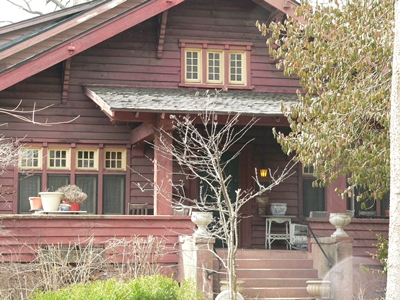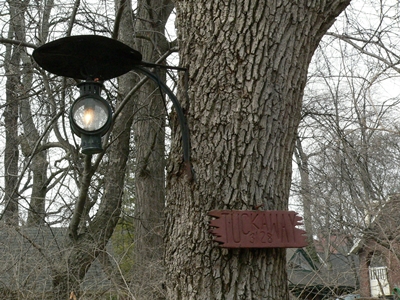 History of Tuckaway
History of Tuckaway
Tuckaway, built in 1906, was purchased by George Philip Meier and Nellie Simmons Meier in 1910. Nellie loved its country cottage look; and even though it was necessary to enlarge and reapportion the structure to accommodate their many elegant possessions and provide a suitable space for entertaining the large social circle the Meiers gathered around them, she insisted that the bungalow effect and setting in the trees be maintained.
The roof was raised and set on the ground. Several rooms at the front were gutted to create a great drawing room. A second story was added at the rear. And the roof was replaced. The sun room was added some time later as a gift from Indianapolis architect and investor, Fermor Cannon. An apartment over the garage — built for the housekeeper — was modified later for Eva LeGallienne, who was a guest of the Meiers while she was doing summer stock in Indianapolis. She called it her “chateau in the tree tops.”
Newspaper articles of the time described the sumptuous furnishings, many of which the Meiers collected on their yearly summer visits to Europe. Photographs taken at the time help us visualize how Tuckaway looked to the many famous people who enjoyed the Meiers’ hospitality and friendship. Various correspondence from these people describe visits and dinner parties there and further add to our understanding of the home and the ambiance it provided.
George Philip Meier was a fashion designer of some reputation in Indianapolis and on the continent. Newspaper articles inform us that he opened a “ladies tailoring and dressmaking residence” at 962 North Pennsylvania on September 10, 1889. Diaries at L.S. Ayres Department Store tell us that they opened a shop for him in their store in 1901, and he remained there until his death in 1931.
Nellie Simons Meier made her international reputation reading palms. Her approach, which she referred to as “scientific palmistry,” was based not on some occult version of fortune telling, but on studying the relationship of lines on the palm to “character traits” and compiling from this “Character Readings.” The great amount of data collected as well as carefully researched books and manuscripts show that Nellie did indeed approach the endeavor as a “study.”
Volumes of correspondence show that her meticulous work was rewarded by the respect of her contemporaries, including Lowell Thomas, Albert Einstein, George Gershwin, Frederick March, Amelia Earhart, Duncan Hines, Margaret Sanger, Elsie de Wolf, Carol Lombard, Mary Pickford, Ramon Navarro, James Whitcomb Riley, Meredith Nicholson among others. At the request of Franklin Roosevelt, 137 palms and character analyses are housed in the Library of Congress. She refused to tell fortunes and seems to have been consulted, often times in the course of a lifetime, by those who appreciated her talent and skill as a counselor. For us, she has provided a glimpse of the personalities of her era and of the concerns which she and her contemporaries felt important.
Longtime owner of the home, Mr. Keene, has called Tuckaway “a study piece of the early twentieth century.” It is especially fine study piece in that so many of the factors that epitomized the era and created the ambiance within which the era unfolded are still available to the student. The house, pictures of the occupants and furnishings, clippings and correspondence of the professional lives and friendships of the owners and most of their famous contemporaries, gowns which George Phillip Meier designed and his family and clients wore, and the memories of friends, clients, and professional associates who knew them are at hand to reconstruct a picture of life in Indianapolis and the popular culture of our nation in the first half of the last century.
After the Meiers glorious reign, Mr. Keene purchased the house in 1972 from their niece, Ruth Austin, a well-known dancer and teacher of modern dance and ballet. Mr. Keene inherited many of the Meiers’ personal effects and has restored the home to its salon-style elegance, adding many of his own finds to enhance and honor its rich history.
For its architecture and historic role, Tuckaway was added to the National Register of Historic Places in the 1980s. At the time of its inclusion, it was one of a few private homes listed on the National Register. Tuckaway sits within the Historic Meridian Park (HMP) neighborhood just a few miles north of bustling downtown Indianapolis. The home is still nestled away in the trees much like when Nellie fell in love with its quiet charm.
Ken Keene and Tuckaway are prominently featured in an article about bungalows in Indianapolis in Indy Spirit in American Bungalow magazine.
Ken Keene
HMP lost an icon when long-time Pennsylvania Street resident Ken Keene died on February 18, 2015. The man who lovingly cared for Tuckaway, the Indianapolis landmark he called home since 1972, was well known for his soirees, amazing stories, and being an advocate for historic preservation. Those of us in HMP also knew him as a dear friend and neighbor.
During the early years of the 20th century, Tuckaway was the home of “scientific palmist” Nellie Simmons Meier, and her husband, the noted fashion designer George Philip Meier. During their residency, the upscale bungalow played host to an endless list of celebrities from the worlds of art, science, and politics. George died in 1934 while Nellie lived until 1944, at which time ownership of the house was passed on to the Meiers’ niece. Ken bought the house from the niece in 1972 and had since preserved the legacy of Tuckaway’s colorful former residents while leaving his own distinctive mark on the house and neighborhood.
Ken’s ownership of Tuckaway almost didn’t happen. As a young 20-something, Ken stumbled upon the house. Eager to purchase the property, he struggled to obtain a loan because banks had “redlined” the area, a discriminatory (and now illegal) practice where entire areas are arbitrarily marked off-limits for loans. But Ken’s father, a WWII general and prominent business and civic leader, intervened and helped Ken secure a loan. Ken paid $12,500 for the house.
Many people assume Ken purchased the home with all its original contents. When one walks into Tuckaway, he or she instantly steps back into time and experiences both the grandeur and intimacy that is evoked by the home’s lavish furnishings. But unfortunately, nearly all of the home’s original contents had been sent to auction by the Meiers’ niece. Over time, through Ken’s expertise of design and furniture, Ken was able to fill the house with furnishings that were appropriate to the house and its history, while reflecting his own personal and unique tastes.
Thankfully, some original items did come with the house, primarily Nellie’s palm prints, personal correspondence, and the numerous autographed photos from the home’s famous visitors that still hang on the walls. But according to Ken, Nellie’s personal affects weren’t the only items that came with the house. On many occasions, Ken claimed to have encounters with the ghosts of Tuckaway’s former owners. Even boarders who rented rooms from Ken had experiences, especially those who slept in Nellie’s bedroom. A master storyteller, Ken always had a ghost story to share or an amazing anecdote linking the house’s past and present. At Tuckaway, you could always expect the unexpected, and as Ken would tell you (and many of his friends would agree), things never happened by coincidence.
Always a gracious host, Ken threw amazing parties for his friends and neighbors. You could always count on a party happening on Christmas, Halloween, and Bastille Day (parties were always on the actual day of the holiday, not the weekend of). Most of the time, however, parties would happen for no reason at all and weere often a decision made that day. But Ken didn’t only share his house with friends. He also welcomed the public to Tuckaway during the HMP Home Tours. Tuckaway was always one of the most popular houses on the tour. He also shared the house with other not-for-profit organizations for fundraisers and special events.
Sadly, in recent years, Ken’s health had been in steady decline. Social events became few and far between as our longtime neighbor and friend became more reclusive. At his request, no memorial service was to be held. Instead, a “Celebration of Life” party, something which he looked favorably upon and helped plan, will be held.
The Indianapolis Star remembered Ken in “Ken Keene put the party in historic preservation” by Will Higgins.
